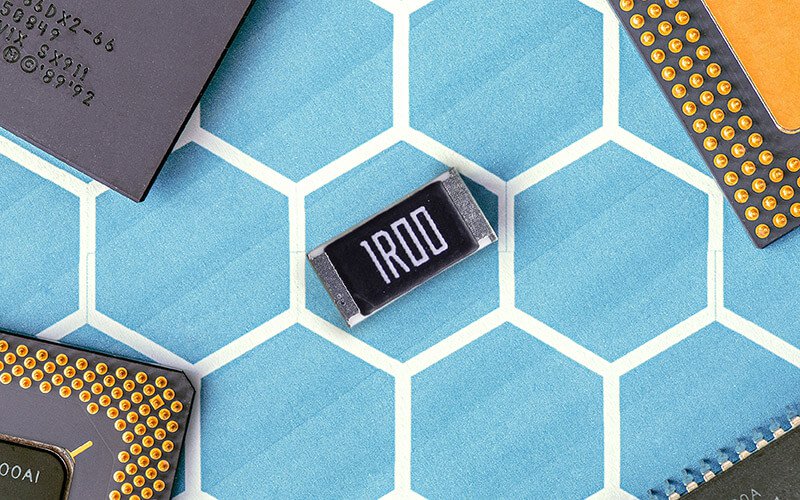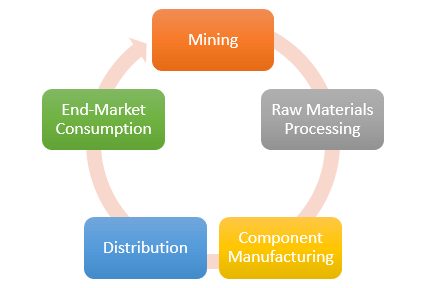
The thick film chip resistor is one of the highest unit count devices produced anywhere in the world. It is designed to satisfy the requirements for hundreds of resistive functions and equations for every handset, computer and automobile – and indeed, for every other electronic device produced on Earth.
Over the past 50 years, the global thick film resistor industry has consolidated into a just few manufacturers, with a narrow supply chain from Asia to the world.
Figure 1: The Passive Electronic Component Supply Chain

An understanding of the passive electronic component supply chain is important in establishing a clear picture of the sub-sets of the global components markets. It is important for the reader to know that the supply chain begins in the ground as mined materials, and ends in the recycling bin.
Why We Need Thick Film Chip Resistors
Thick film chip resistors are ubiquitous in electronic devices because resistance is required to achieve an electronic circuit.
The reasons why thick film chip resistors are required in electronic circuits is to impede current flow and create a voltage drop in the circuit. Both alternating and direct currents are impeded by resistance in a circuit; however, DC circuits require the massive volumes of thick film chip resistors.
The resistance of a circuit is measured in ohms – the amount of resistance required to create a voltage drop of one volt when the current flow is one ampere. Subsequently, thick film chip resistors come in many ohmic values that are directly proportional to the physical size or available surface area of the resistive element(s) per substrate.
The use of thick film chip resistors comprised of ruthenium oxide paste on an alumina substrate is the preferred method of design engineers to achieve the required resistance. The global unit volume of thick film chip resistor consumption accounts for 40 percent of the volume of all components on any given printed circuit board.
How Thick Film Chips are Constructed
The thick film chip resistor will usually have at least one deposited resistive element. The resistive element is usually based upon a ruthenium-oxide thick film paste that is deposited using screen printing techniques on 96 percent alumina ceramic substrates.
The thick film resistive element is constant in thickness with a geometry comprised of small squares. The width and thickness of the resistive element helps establish the power rating of the thick film chip resistor and the number of squares determines the overall resistance of the finished component.
The challenge of ultra-small resistor technology is to produce as many squares on the resistor as physically possible. This ultra-small resistor trend has carried the industry for 40 years as each new generation of component advances resistor technology to the next level in compact size. In 2021, the smallest products on the market are less than 01005 chip case size (EIA-dimensions in inches).
Thicker squares and wider squares will each impact the ability for the chip to carry more current and to handle more power, but the number of squares and subsequent resistance per component is reduced, creating a challenge to design engineers to maximize the resistance in ultra-small packages.
Due to the relative limited technology barriers for market entrance, the competitive advantage is having massive economies of scale to produce thick film chips. Another way to add value is to create chip variety.
As a result of the massive and abundant variations in thick film resistor construction and design, the following product categories have been identified.
General Purpose Thick Film Chip Resistors
Used for voltage reduction and current control and available from the ultra-small case size 01005 (EIA) to large case size 2512 (EIA) with operating temperature range from -55 C to 155 C, these have nominal values from 0 ohms to 20 MOhm with power ratings from 0.01W to 2W.
Ultra-Small 01005, 009005 and 0075 Case Size Ru02 Thick Film on 96 Percent Alumina and Smaller Trends – These thick film chip resistors have physical dimensions smaller than 0201 and are considered cutting edge. Others cannot compete because the technology is too challenging. This product is manufactured from ruthenium oxide resistive materials screen-printed on a ceramic alumina substrate and terminated with solderable metal endcaps.
This product enables portable technology and is largely consumed in modules that are in turn consumed in handsets and watches and other compact electronics. KOA, ROHM, Yageo, Vishay and Bourns all have an 01005 to match the needs of the sister components in MLCC as prototypes – and these are large volume markets. Both ROHM and Yageo have taken this to the next level of smallness and include the ROHM (Rasmid) at 009005 inches and the Yageo 0075 inches.
Thick Film Chip Resistors (0201 Case Size Ru02 Thick Film on 96 Percent Alumina and Smaller Trends) – This variety has the physical dimension of 0.02 x 0.01 inches and is extremely small, no bigger than a grain of salt. This product is manufactured from ruthenium oxide resistive materials screen-printed on a ceramic alumina substrate and terminated with solderable metal endcaps.
This product enables portable technology and is largely consumed in wireless handsets and enables module circuitry. It is used for creating ohmic values in all electronics and is a ubiquitous product line, produced worldwide in the hundreds of billions of pieces.
Thick Film Chip Resistors (0402 Case Size Ru02 Thick Film on 96 Percent Alumina) – This component class has the physical dimension of 0.04 x 0.02 inches and is extremely small. This product is manufactured from ruthenium oxide resistive materials screen-printed on a ceramic alumina substrate and terminated with solderable metal endcaps.
This product enables portable technology and is largely consumed in wireless handsets, computers and TV sets. It is used for creating ohmic values in all electronics and is a ubiquitous product line, produced worldwide in the hundreds of billions of pieces. The 0402 is the largest volume chip resistor produced worldwide in terms of volume.
Thick Film Chip Resistors (0603 Case Size Ru02 Thick Film on 96 Percent Alumina) – This component class has physical dimension of 0.06 x 0.03 inches and is small. This product is manufactured from ruthenium oxide resistive materials screen-printed on a ceramic alumina substrate and terminated with solderable metal endcaps.
This product is largely consumed in computers, automobiles and TV sets. It is used for creating ohmic values in all electronics and is a ubiquitous product line, produced worldwide in the hundreds of billions of pieces.
Thick Film Chip Resistors (0805 Case Size Ru02 Thick Film on 96 Percent Alumina) – This “thick film chip resistor” TFCR has the physical dimension of 0.08 x 0.05 inches and is small. This product is manufactured from ruthenium oxide resistive materials screen-printed on a ceramic alumina substrate and terminated with solderable metal endcaps.
This product is largely consumed in computers, automobiles and TV sets. It is used for creating ohmic values in all electronics and is a ubiquitous product line, produced worldwide in the hundreds of billions of pieces.
Thick Film Chip Resistors (1206 Case Size Ru02 Thick Film on 96 Percent Alumina) – This “thick film chip resistor” TFCR has the physical dimension of 0.12 x 0.06 inches and is small. This product is manufactured from ruthenium oxide resistive materials screen-printed on a ceramic alumina substrate and terminated with solderable metal endcaps.
This product is largely consumed in computers and automobiles. It is used for creating ohmic values in all electronics and is a ubiquitous product line, produced worldwide in the hundreds of billions of pieces.
Thick Film Chip Resistors (1210-2512 Case Size Ru02 Thick Film on 96 Percent Alumina) – Has physical dimensions of 0.12 x 0.10 to 0.25 x 0.12 inches and is large compared to other components. This product is manufactured from ruthenium oxide resistive materials screen-printed on a ceramic alumina substrate and terminated with solderable metal endcaps.
This product is largely consumed in industrial electronics. It is used for creating ohmic values in all electronics and is a ubiquitous product line, produced worldwide in the tens of billions of pieces.
Thick Film Chip Resistors Ultra-Large 3921 and 5931 Case Size Ru02 Thick Film on 96 Percent Alumina) – Extremely large chip size; the only vendor competing here is ROHM. This product line is good for large voltage applications that require very high current sense capabilities.
Current Sense Thick Film Chip Resistors
These resistors detect and convert current to voltage that is proportional to the amount of current travelling through the circuit. Current sense thick film chip resistors create a voltage drop when voltage is present across the resistor. Current sense resistors are generally less than one ohm to avoid excessive power consumption in power supply and battery management circuits.
High Voltage Thick Film Chip Resistors
High voltage thick film chip resistors are consumed in power supplies and related circuitry in applications above 50 volts, with specialty surface mount designs available to 35 kV. Applications include industrial motor control, medical test and scan, laboratory test equipment, TV transmitters, welding equipment and radar. The technology employed here is designed so that the finished component withstands unique high voltage circuit arcing and related lightning-induced or motor-switching-induced transients.
Environmentally Compliant and Friendly Thick Film Chips
Anti-sulfur, RoHS-compliant and halogen-free thick film chip resistors are designed to help develop a supply chain that is environmentally conscious and friendly. Anti-sulfur chips are designed with specific additive materials that enable the chips to operate in sulfuric or high metal containment conditions. These resistors are consumed where rubber tires and electronics come into proximity and where industrial catalysts are in operation. Additives prevent the formation of silver sulfide at the resistor termination.
AECQ-200 Thick Film Chip Resistors
Thick film chip resistor products that qualify as AECQ200 parts all automotive end markets in nature and must adhere to the stringent requirements of temperature and mechanical shock.
Precision Thick Film Chip Resistors
A “precision” type thick film chip resistor is one that does not demonstrate much change in resistance with temperature. The variation in change in ohmic value on precision chip resistors may be as tight as +/- 0.01 percent
High Power Thick Film Chip Resistors
These components have a substrate and materials design that improves the thermal handling properties of the finished chip in order to provide improved heat dissipation. These are suited for applications subject to high current or where a large derating margin is required, such as high temperature electronics (i.e. oil and gas applications and space electronics).
High Resistance Thick Film Chip Resistors
These specialty resistors find markets in circuits requiring high impedance, such as test and measurement equipment and laboratory electronics; they are also used in voltage dividers or gain setters. Resistance values may go as high as 100 GOhm.
Thick Film Chip Resistors: A Rendered Economy
Thick film chip resistors represent what is termed a rendered economy. This is defined as a product economy where other manufacturers to not wish to compete because of hurdles regarding return on investment and profitability.
A detailed analysis of the thick film chip resistor market reveals that the barriers to entry are in fact the massive economies of scale required to compete (a large investment in capital equipment) and a very thin profit margin. Of course, the variable is that the product is ubiquitous and designed into every printed circuit board manufactured regardless of end-market, which allows market access for other products and services.
The risky nature of thick film chip resistors lies in their reliance upon specific raw materials such as ruthenium in their resistive pastes (Ru02).
Thick film chip resistors have a unique aspect in that they require massive economies of scale to be successful; therefore, business owners must be able to imagine production of units on a scale in the hundreds of billions of pieces, and must have the vision to imagine factories of the future that can produce trillions of pieces.
End-Market Consumption
The traditional product based end-markets into which these components are sold include consumer audio and video, telecommunications, computers and peripherals, automotive, industrial and specialty market segments.
Within each category, specific products stand out as passive-component-intensive products that consume large quantities of capacitors per unit: TV sets, wireless handsets, notebook computers and tablet computers, power supplies and automobiles.
Automotive markets can be further broken down based upon under-the-hood applications and passenger compartment applications, or alternatively by fossil fuel vehicle electronics or battery electric vehicle propulsion. The industrial market segment can be further broken down into power supplies, DC/DC converters, renewable energy systems, motors, fans and blowers, switchgear and switchboard applications, lighting and other line voltage equipment. The “specialty markets” category can be broken down into defense and aerospace, medical electronics, undersea cable, mining electronics, railroad electronics, instrumentation and control equipment, maritime electronics and oil-and-gas services electronics.
Based upon world region, the Asia-Pacific region accounts for between 70 percent and 80 percent of all components produced and consumed. China and Japan are the two largest producing and consuming countries for thick film chip resistors, but Korea, Singapore, Philippines, Thailand, Malaysia and Indonesia are also key countries that build larger assemblies requiring thick film chip resistor components to operate.
The Americas and Europe account for the remaining consumption of thick film resistor components each; key consuming countries are Germany, the U.S., Mexico, Brazil, the Czech Republic, Hungary, the UK, France and Italy.
Market Outlook for Thick Film Chip Resistors
Technology trends in this industry will be investments in ultra-small case size chips for the handset and module businesses, i.e. those that go below the 01005 chip case size – but also, a reinvigoration of larger case size chips for high-voltage applications in battery electric vehicle propulsion.
The exposure to ruthenium is substantial for the industry and the impact of such wide variations in materials prices have adverse effects on contracts with respect to both costs to produce and profitability.
Regardless, the investment in worldwide pick-and-place equipment supporting so many different chip case sizes suggest that a continued reliance on thick film chips is evident for the foreseeable future. Supply chain issues regarding pandemic idling and closures will have a temporary disruptive effect on the global component supply chains, but thick film chip resistors are one area where the cost structure has demonstrated substantial volatility. This volatility will generate more interest in alternative technologies such as thin film alternatives.
However, overall growth in volume and value is expected to be the norm for thick film chips to support new realities in its narrow supply chain.
Summary and Conclusions
- Thick film chip resistors are ubiquitous components required in every electronic circuit produced globally.
- The market for these resistors is considered a rendered economy because of the massive economies of scale required to compete and the low profitability of the supply chain.
- Technical barriers for market entry are not significant when compared to other passive component product lines and limited to materials and case size development.
- The methods of creating differentiation in a rendered economy are through product variety, which in the instance of mass produced thick film chip resistors include case size and performance characteristics and environmental capabilities.
- Thick film chip resistors are raw materials intensive, with emphasis upon the use of ruthenium pastes and alumina substrates.
- Raw material price increases have impacted the supply chain for thick film chip resistors, creating extended lead times for all case sizes through July 2021.
Follow TTI, Inc. on LinkedIn for more news and market insights.
Statements of fact and opinions expressed in posts by contributors are the responsibility of the authors alone and do not imply an opinion of the officers or the representatives of TTI, Inc. or the TTI Family of Specialists.

